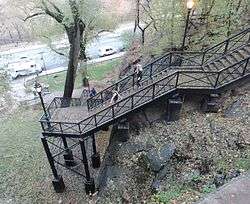John T. Brush

John Tomlinson Brush (June 15, 1845 – November 26, 1912) was an American sports executive who is primarily remembered as the owner of the New York Giants Major League Baseball franchise from 1890 until his death. He also owned the Indianapolis Hoosiers in the late 1880s, and the Cincinnati Reds from 1891 to 1902. Under his leadership, the Giants were revived as a franchise after a decline during the 1890s. Brush was also a leader in the formation of the rules that govern the modern World Series. He was one of 11 executives honored by the Baseball Hall of Fame on a Roll of Honor in 1946.
Biography
Born in Clintonville, New York, Brush was orphaned at age 4 and was raised by his grandfather until he left to enter business college at age 17. During the Civil War he enlisted in the First New York Artillery in 1863, and after the war's end he went into business running clothing stores in Albany, Troy and Lockport, New York. He moved to Indianapolis in 1875, eventually opening a department store, and became involved in local baseball as a means of promoting his store. He built a ballpark in 1882, and it became home to the Indianapolis Hoosiers of the American Association for their only major league season in 1884; they played in the Western League before that circuit folded after the 1885 campaign.
When the National League put the St. Louis Maroons franchise up for sale after the 1886 season, Brush bought it and relocated the team to Indianapolis. He renovated his ballpark, adding a special celebrity box which attracted such figures as President Benjamin Harrison, poet James Whitcomb Riley, and future novelist Booth Tarkington. In 1888 he offered a tryout to Bud Fowler, but ultimately decided not to challenge the sport's color line. Brush also devised a salary scale system which was designed to curtail player salaries, a move which helped contribute to the breakaway Players' League in 1890.
When the Indianapolis team folded after the 1889 season, Brush was compensated with $67,000 and a share of the Giants franchise, along with a promise of the next available team; he quickly acquired the Reds club after its financial collapse during the three-league competition of 1890. Instead of relocating, he kept the team in Cincinnati, and survived a challenge from a short-lived American Association competitor, the Cincinnati Kelly's Killers. Brush frequently was at odds with sportswriter Ban Johnson of the city's Commercial Gazette, and in an attempt to reduce the writer's local influence he helped Johnson become president of the new Western League – a move which eventually backfired when the league achieved major status as the American League in 1901, with Johnson remaining as president.
As chairman of the NL's executive committee, Brush took a lead role in combating the AL, joining with Giants majority owner Andrew Freedman to sabotage the AL's Baltimore club by offering the managing jobs of the New York and Cincinnati teams to John McGraw and Joe Kelley respectively; Baltimore was forced to relocate to New York after 1902, eventually becoming the New York Yankees. The acrimony also contributed to controversy in the selection of a new NL president in 1902, as the Giants supported incumbent president Nicholas Young against Albert Spalding, who favored better relations with the AL; in the deadlock, both candidates were forced to withdraw, with Harry Pulliam being selected as a compromise choice. Freedman left baseball shortly thereafter, with Brush taking over as majority owner and team president, selling his interest in the Reds for $180,000 to a group headed by Garry Herrmann. When the Giants won the 1904 NL pennant, Brush refused to allow the team to meet Boston's defending champions in the World Series due to his animosity toward Johnson; a permanent agreement between the leagues was eventually made after meeting some of Brush's conditions, and the Giants won the 1905 World Series against the Philadelphia Athletics.

Brush's health deteriorated quickly after becoming majority owner in 1902, as he suffered from locomotor ataxia, a nervous system affliction, as well as rheumatism. The Giants won another pennant in 1911, the same year in which he oversaw the reconstruction of the Polo Grounds. Brush attended World Series games as the team again advanced in 1912, but his failing health was apparent, particularly in the aftermath of an auto accident that September 11 in which his car was struck by a truck and overturned, causing two broken ribs. After the Series he left by train to recuperate in California, but died in his private car near Louisiana, Missouri; his car was detached and rerouted to St. Louis, and his body was returned to Indianapolis. His funeral was held at St. Paul's Episcopal Church, with accompanying Masonic rites. He was succeeded as Giants president by his son-in-law, Harry Hempstead.
In 1913, the Giants organization constructed a stairway from the ticket booths on Coogan's Bluff to the Polo Grounds below, and presented it to the City of New York in honor of its late owner. The John T. Brush Stairway still stands,[1] and was restored by the city in 2013.[2]
References
- ↑ Williams, Timothy (19 February 2008). "A Stairway to Sports History From the Polo Grounds". The New York Times. Retrieved 2 December 2012.
- ↑ Walsh, Kevin (November 2014). "HAMILTON and WASHINGTON HEIGHTS". Forgotten NY. Retrieved 6 November 2014.
- Baseball: The Biographical Encyclopedia (2000). Kingston, New York: Total/Sports Illustrated. ISBN 1-892129-34-5.
- Reach Official American League Base Ball Guide (1913). Philadelphia, Pennsylvania: A.J. Reach Co.
- Allen, Lee. The National League Story (1961). New York: Hill & Wang.
- Allen, Lee. The American League Story (1962). New York: Hill & Wang.
External links
- BaseballLibrary
- SABR biography
- New York Times obituary
- "John T. Brush Collection, 1912–1975", Indiana Historical Society
- "John T. Brush – A Power in Baseball" (PDF). (337 KB) – by John B. Foster